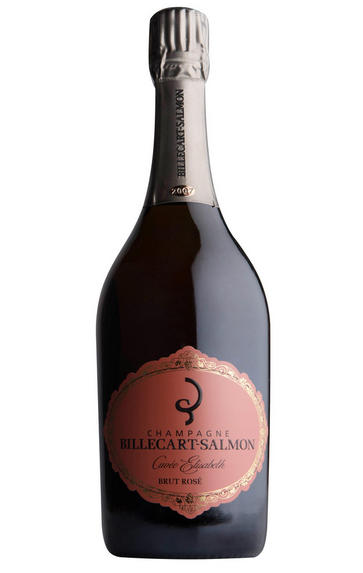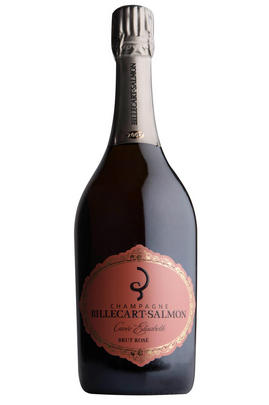
2009 Champagne Billecart-Salmon, Cuvée Elisabeth Salmon, Rosé, Brut

Critics reviews
The 2009 Brut Rosé Cuvée Elisabeth Salmon is such a joyous Champagne. Intensely floral and effusive, the 2009 is a real charmer. Kirsch, sweet red cherry fruit, orange peel, mint, chalk and white pepper are all finely woven together. This is an especially brisk style, both for the year and for Billecart. If anything, the dosage feels a bit low here, which gives the wine chiselled contours and a slightly austere personality.
Drink 2027 - 2039
Antonio Galloni, Vinous.com (May 2022)
Incorporating fully 10% still red wine, Billecart's 2009 Brut Rosé Cuvée Elisabeth Salmon is showing beautifully, delivering fragrant aromas of plums, stone fruits, petals, sweet spices and marzipan. Medium to full-bodied, fleshy and elegant, it's seamless and pillowy, with bright acids and a pure, precise profile, concluding with a bright, saline finish. In 2009, it was vinified entirely in stainless steel.
Drink 2022 - 2035
William Kelley, Wine Advocate (August 2022)
Very pale glowing salmon-orange colour. Rich, complex, burnished copper (somehow) nose. Very luscious and seductive. Strawberry flavours but not sweet and simple at all. Creamy-smooth texture but with quite enough acidity – even in this ripe vintage – to keep this wine appetising and intriguing on the finish. Great stuff! A wine to send you to the table…
Drink 2021 - 2028
Jancis Robinson MW, JancisRobinson.com (October 2022)
Copper-orange colour with aromas of grapefruit pith, cherry stones, dried roses, white pepper, pastries, walnuts and oyster shells. Refined and elegant with pretty, dried red and citrus fruit, layered with subtle spice and toast. Fine bubbles. Dry. 55% Pinot Noir from Mareuil-sur-Ay and Ay, and 45% Grand Cru chardonnay from Cote des Blancs, with 10% Pinot Noir red wine. Dosage 7g/L. Disgorged in July 2021.
Drink or hold
James Suckling, JamesSuckling.com (August 2022)
A slightly flinty and vibrant bouquet alongside complex aromas of red berries, herbs and lemon, with fresh menthol notes coming through with some air. The palate is wonderful and elegant, with a vinous texture and a superb, calcareous finish. A blend of 45% Chardonnay and 55% Pinot Noir (including 9% vinified as red wine), this Champagne, which has a dosage of 7g/L, is made for ageing.
Drink 2023 - 2050
Yohan Castaing, Decanter.com (November 2022)
About this WINE

Champagne Billecart-Salmon
Champagne Billecart-Salmon was founded in 1818 in the village of Mareuil-sur-Aÿ near Epernay. It remains family-owned and run; Mathieu Roland-Billecart represents the seventh generation here, following in the footsteps of founders Nicolas-François Billecart and Elisabeth Salmon.
A family tasting committee meets weekly, joined by chef du cave Florent Nys. The eight-person panel includes three generations of the family, notably including Jean Roland-Billecart (who alone has over 75 vintages of experience). Not one cuvée is released until every member of the committee agrees on the blend.
Billecart-Salmon is a large Champagne House, with around 100 hectares of vines of its own. The process of organic conversion for the vineyards was started in 2019. The house also buys fruit from growers covering another 300 hectares of vines. Most of the fruit comes from the Champagne sub-regions of Montagne de Reims, Vallée de la Marne and Côte des Blancs.

Rosé Champagne
Rosé wines are produced by leaving the juice of red grapes to macerate on their skins for a brief time to extract pigments (natural colourings). However, Rosé Champagne is notable in that it is produced by the addition of a small percentage of red wine – usually Pinot Noir from the village of Bouzy – during blending.
Recommended Producers : Billecart Salmon (Elizabeth Salmon Rose), Ruinart

Champagne blend
Which grapes are included in the blend, and their proportion, is one of the key factors determining the style of most Champagnes. Three grapes are used - Pinot Noir, Chardonnay and Pinot Meunier.
26% of vineyards in Champagne are planted with Chardonnay and it performs best on the Côtes des Blancs and on the chalk slopes south of Epernay. It is relatively simple to grow, although it buds early and thus is susceptible to spring frosts. It produces lighter, fresher wines than those from Burgundy and gives finesse, fruit and elegance to the final blend. It is the sole grape in Blancs de Blancs, which are some of the richest long-lived Champagnes produced.
Pinot Noir accounts for nearly 40% of the plantings in Champagne and lies at the heart of most blends - it gives Champagne its body, structure, strength and grip. It is planted across Champagne and particularly so in the southern Aube district.
The final component is Pinot Meunier and this constitutes nearly 35% of the plantings. Its durability and resistance to spring frosts make the Marne Valley, a notorious frost pocket, its natural home. It ripens well in poor years and produces a soft, fruity style of wine that is ideal for blending with the more assertive flavours of Pinot Noir. Producers allege that Pinot Meunier lacks ageing potential, but this does not deter Krug from including around 15% of it in their final blends.


Buying options
Add to wishlist
Description
Cherry stones, blood oranges and wild strawberries woven with aromas of freshly baked blackberry tartlets. The palate is woven with red berries, cream fraise, lemon pith and sun-kissed peach skin, supported by a seamless golden foam, pinot details and bright, saline minerality. A rich year in Champagne, yet this Rosé is agile, impressive and cellar-worthy. But utterly enjoyable now. Over 10 years on lees give profound richness and complexity (7g dosage).
Drink now to 2035
Davy Zyw, Senior Buyer, Berry Bros. & Rudd (November 2022)
wine at a glance
Delivery and quality guarantee